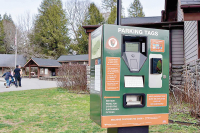Scouting a Smokies Blueway Trail: Recreation abounds, but knowing where and how to tap it can be a mystery
 The mountains rising above the valleys have long been the main attraction for tourists planning a trip to Western North Carolina, but a regional initiative between local government and private entities is looking to capitalize on the recreational potential riding on the rivers beneath.
The mountains rising above the valleys have long been the main attraction for tourists planning a trip to Western North Carolina, but a regional initiative between local government and private entities is looking to capitalize on the recreational potential riding on the rivers beneath.
The creation of a N.C. Smokies Blueways Trail will link the paddling, fishing, swimming and boating spots on rivers and lakes in the region under one banner.
However, figuring out how and where to go to enjoy the region’s lake and rivers — from Wildlife Commission fishing piers to forest service paddling put-ins — can be a mystery to locals, let alone tourists.
“This is an opportunity to leverage our assets in tourism,” said Ryan Sherby, interim executive director of the Southwestern Commission, a regional economic development entity.
Sherby, a paddler himself who lives in Bryson City, believes the region needs to start marketing itself as a grade A tourist and water recreation destination.
Tourism has been often overlooked because it was viewed as seasonal and low paying, he said. But that’s changing.
Related Items
“There’s a slow shift in acknowledging the tourism sector is a viable sector in this economy,” Sherby said. “Tourism brings real money.”
The first step in creating a Smokies Blueways Trail is simply to map all the water recreation assets in the region — indeed, that alone is the crux of the Blueways trail initiative. Sherby hopes it will provide a guide for tourists looking to raft, kayak, swim, fish or participate in other water-related activities.
The creation of the Blueways Trail will be paid for by a $85,000 Duke Energy Foundation grant.
Of the grant money, $5,000 will be used for mapping. Western Carolina University staff and students will use another $5,000 to create a multimedia guide to promote a section of the Tuckasegee River near campus.
The remainder of the money will be used to market the region’s lake and river recreation through Smoky Mountain Host, a regional tourism promotion entity.
In the limelight
The timing is opportune. The creation of the Blueways Trail coincides with the build-up to the 2013 Freestyle World Championships being held on the Nantahala River.
Sherby hopes to have the mapping portion of the new Blueways Trail prepared by the start of the international kayaking competition as well to capitalize on the increased traffic and showcase the local water hotspots.
The event is the premier competition for freestyle boating — a type of paddling not based on a race, but instead performing tricks such as flips and somersaults with kayaks and canoes.
The event is expected to draw 10,000 people in early September, most of them boaters coming for the competition but also looking to enjoy the local rivers.
“The ultimate goal is to have (the maps) ready for the 2013 games,” Sherby said. “So we can share with those tourists other recreation opportunities in region. They may want to go fly-fishing or know where public river access is.”
But, the recreation maps will also have a lasting use after the weeklong competition has ended.
Blueways of the Appalachians
The initial Blueways Trail will focus on four rivers — the Nantahala, Tuckasegee, Oconaluftee and Little Tennessee. The project has being heralded as a pilot project under a new National Blueways System, under the auspice of the U.S. Department of Interior.
The idea to highlight river-based recreation through national system of “trails” is part of America’s Great Outdoors initiative launched by President Barack Obama in 2011.
Last spring, the Connecticut River was designated the first of these Blueways Trails. The Smokies project is already on the Department’s radar, along with a handful of other rivers, as pilot projects for this expanding series of national waterways.
Once completed, the N.C. Smokies Blueways Trail will have to apply for formal federal designation, however, according to Betty Huskins, a tourism and marketing consultant and project manager in the region and also a member of the U.S. Sport Fishing and Boating Partnership Council.
Huskins feels the N.C Smokies Blueways Trail has a good shot at getting the official federal designation — especially since it is in on the ground floor of the initiative.
“We have been included as one of the pilot projects,” Huskins said. “They want to work with areas that they see have potential.”
The 400-mile Connecticut River, which was given the honor only as recently as May, stood out because of coordinated conservation efforts along the river corridor by citizens, local government and nonprofits. Local organizers are hoping to replicate the model in WNC.
As part of the Duke grant, $5,000 will go to visual arts students and faculty at WCU for a video and photo project on section of the Tuckasegee River in Jackson County near campus.
Information on plants, fish, geology, history and recreation from that section of the river will be synthesized into an interactive website and mobile app to promote the Blueways project. That segment could serve as an information-gathering model as the water trail system expands.
From paper and textiles to paddles and lures
Although the Blueways initiative is a new concept, bringing tourists to Western North Carolina for water-related recreation is no feat.
The formula has worked for at least two water-based recreation destinations in the region:
• Cherokee has become a world-renown fishing destination utilizing aggressive fish stocking and marketing techniques to entice anglers.
• The Nantahala Gorge funnels thousands of tourists into it narrow walls with the promise of churning whitewater and a great time in the great outdoors.
According to a local economic analysis, recreation on the Nantahala River has an $85 million impact on WNC and sustains more than 1,000 jobs. The Nantahala Outdoor Center, which is one of the largest outfitters on the river, is also the largest employer located in the Swain County.
Although sometimes overlooked in the quest to lure golfers or other perceivably more affluent tourists, Sutton Bacon, CEO of the NOC, demonstrated that granola-eating, paddle-toting boaters are actually an economic force to be reckoned with.
The typical visitor to WNC who comes for outdoor recreation has a household income of $89,000 per year, spends an average of two or more nights in the area and spends nearly $800, Bacon wrote in a report.
Nationwide, Americans spend an estimated $646 billion on outdoor recreation.
And developing the region’s ability to attract those visitors, may be a more worthwhile way to grow the economy.
“The public lands and waters in our region are the pathway to a growing and sustainable prosperity — a type of prosperity that cannot be outsourced overseas,” Bacon wrote in an email. “Whereas extraction and manufacturing industries have come and gone.”
That type of outdoor tourism in Swain County, although it remains one of the poorest in the region overall, has given Jackson County Manager Chuck Wooten something to think about. He said it is apparent his county is not likely to attract new industry so he is excited at the prospect of having new recreation opportunities on the Tuckasegee to pitch to potential water-goers.
“There’s a lot of money being spent on outdoor recreation,” said Wooten. “There’s no reason we couldn’t have, maybe not an NOC, but something of its size.”
Wooten said the WNC Fly-fishing Trail based in Jackson County and created by the Jackson Chamber of Commerce has already showed success in attracting outdoor recreationists.
And the timing couldn’t be more perfect to expand such a campaign to bring outdoor enthusiasts.
“We ought to publicize and advertise with all the resources we have,” Wooten said. “I don’t know that (outdoor recreation) has been overlooked — I think it’s been taken for granted.”
Coalescing with rivers and lakes
Several developments in the field of aquatic recreation —everything from kayaking to fishing to motorboating — are paving the way for an organized push from tourism industry leaders to highlight the Blueways Trails of the Smokies.
The short list of unfolding events includes:
• Duke Energy, which operates 10 hydropower dams on five rivers in the region, is constructing new river and lake access areas as well as a series of whitewater releases from its dams.
• The world freestyle paddling competition coming to the Nantahala Gorge next September is expected to draw thousands of visitors and work as a stage to showcase the water resources of the region.
• The N.C. Smokies Blueways Trail in the making (see related article).
The wheels are already turning as to how these loosely connected events can be wielded as an organized money-making machine to boost local tourism dollars and bring economic growth to the area.
Last week, a group of representatives from county, state and tribal governments as well as tourism-based business owners and marketing agents met at a summit put on by Smoky Mountain Host, a regional tourism marketing entity, to discuss the untapped potential of the region.
One of the biggest boons to water-based recreation in the region is the new amenities being rolled out by Duke on both rivers and lakes.
In coming years, Duke Energy will make numerous recreational improvements on the rivers and lakes in exchange for federal permits to operate a series of 10 hydropower dams in the region. The new recreational amenities were required for Duke to continue to use public waterways to create electricity.
This time around, recreationists have a lot to look forward to as the new agreement promises improved water access, wildlife viewing areas, boat camping and fishing trails.
Also, as part of the new agreement, a handful of times per year, Duke will release water from its dams on the upper Nantahala and Tuckasegee to create world-class whitewater downstream. The inaugural release on the Upper Nantahala River this fall was a widely popular event for boaters.
Mark Singleton, executive director of American Whitewater, a national organization of paddling enthusiasts headquartered in Sylva, helped negotiate for the recreational improvements with Duke Energy in the licensing process. His organization was one of a group of stakeholders representing conservation and recreational interests.
The results of negotiations will change the face of paddling in the region, he said.
“What you have is this whole new mix of recreational products coming into the region as a result of the Duke relicensing,” Singleton said.
The list includes some 30 or so lake and river access points on the Nantahala, Tuckasegee, Little Tennessee and Oconaluftee rivers. Some are designed with bathrooms, concrete boat ramps and parking areas, while others may consisted of a new fishing pier at an existing access area.
“Each one of those access areas is a pretty big deal,” Singleton said. “It connects people to the river.”
The creation of a N.C. Smokies Blueways Trail will highlight many of the new river and lake improvements Duke Energy has planned.









